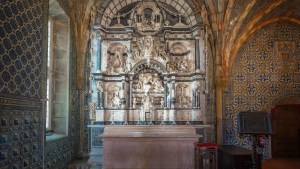Lenten Campaign 2025
This content is free of charge, as are all our articles.
Support us with a donation that is tax-deductible and enable us to continue to reach millions of readers.
After three years of careful restoration, a medieval painted crucifix by the Early Renaissance Italian master Ambrogio Lorenzetti has been brought back to life, showing off the beauty it had back in the 14th century. Lorenzetti, a leading Sienese painter, worked on this crucifix in 1329 or 1330. It is now on display at the Convent of San Niccolò al Carmine in Siena.
As read in the note published by Medievalists.net, this piece shows how Lorenzetti was influenced by Giotto early on – while also showcasing elements of his mature style, such as the intricate decorations on the tabellone (that is, the body of the cross) and Christ’s halo. Despite some missing parts, the Crucifix exemplifies the elaborate carpentry and Gothic design typical of Sienese crosses from the 14th and 15th centuries.
The way Lorenzetti depicts Christ shows his mastery at handling naturalistic elements. The Sienese maestro drew the anatomy of Christ’s body, using nuanced chiaroscuro to define muscles and make the contrast between shadowed areas and the lighter complexion of the figure stand out. The bright red drops of blood create a striking contrast.
Lorenzetti’s work also shows a somewhat Giotto-esque psychological depth. The crucifix captures the moment just before Christ’s final breath on the Cross. The head tilts forward dramatically, accentuated by the halo in relief, while the lips are tinged with a hint of blue, and the drooping eyelids poignantly convey suffering.
This is a typical classical gesture, inherited by Christian art: as in the Greek Discobolus of Myron, the figure is represented in either the maximum or the minimum movement of muscular tension, right before a decisive action occurs.
The restoration, Medievalists.net explains, dealt with major problems, including damage from rainwater in the 19th century. A previous restoration led by Cesare Brandi at the Istituto Centrale del Restauro in the 1950s removed older repainting, but it left the original artwork in pieces.

Cristina Gnoni, then Director of the Musei Nazionale di Siena, promoted a new restoration project after a 2017 exhibition in Siena. Friends of Florence, a U.S. nonprofit that works to preserve Florentine cultural heritage, finally funded the restoration.
This masterpiece is now on display in a dedicated gallery at Siena’s Pinacoteca until January 8, 2024.

After the temporary exhibition concludes, the Carmine Crucifix (as it is popularly known, after the convent hosting it) will return to Room 7 in the Musei Nazionale di Siena, where it will be displayed alongside other works by Lorenzetti (1290-1348).
Lorenzetti is best known for his fresco illustrating Good Government in the Palazzo Pubblico, Siena’s town hall.



